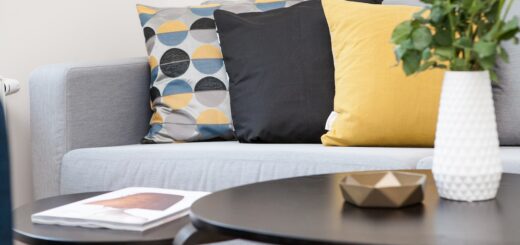Tile Cutter
Tile Saw
Grout and Adhesive Spreading Tool
Spirit Level
Tile Nippers
Tile-Cutting Jig
Preparation
One of the most important factors in any tiling project is thorough planning. It is not usually a good idea to just start in the corner with a full tile and work up or across from that. This might leave you with a small and unsightly row at the top or side of the wall or floor.
To avoid this problem, make yourself a gauge stick before you start. Take a length of 50mm x 12mm soft wood and lay a row of tiles along one edge of it. Use spacers as you would normally so that the tiles are spaced properly, then mark the position of each tile on the gauge stick.
Before you begin tiling, you must ensure that the walls are clean, unbroken and dry. The surface should be as flat as possible so you’ll need to take off any wallpaper and paint over any flaking paint. Make sure you have your gauge stick ready.
Laying Out Tiles
The size and shape of your bathroom will decide how you set out the walls. Mark the bottom of the lowest row of tiles and nail a thin guide strip to the wall, aligned with the mark (you can take this off later so don’t hammer it in too heavily). Use the spirit level to ensure that this is perfectly horizontal.
Mark the centre of the wall and use the gauge stick to set out the rows of tiles on each side of it. If the border tiles measure less than half the width of a tile, reposition the rows sideways by half a tile as equal borders all round give a better-looking finish. Use the spirit level to place a guide strip against the last vertical line and again temporarily nail it to the wall.
If you are going to need to tile around something large and awkward like a window, use that as your starting point instead so you get equal-sized tiles around it. Again use a temporary guide strip to position the rows as needed. Make sure you put any cut tiles at the back of the window’s reveal.
Applying The Adhesive
Make sure you are using waterproof tile adhesive for areas that will come into contact with water (very likely in a bathroom)! Most tile adhesives are sold pre-mixed, but you do need to add water yourself to some. Apply the adhesive to the wall so that it covers about one square metre.
Now use the toothed edge of the spreader to form horizontal ridges in the adhesive. Take the first tile and place it in the right angle formed by the setting out strips. If the tiles don’t have lugs on them, put plastic spacers between them so there will be enough space for the grouting afterwards.
Use a damp sponge to wipe away any excess adhesive from the surface of the tiles. Tile along the guide strip until the first rows are complete, making sure that each tile is properly horizontal. When you’re done, make sure you allow the tiles to set before you take the guide strips off.
Cutting Border Tiles
Once you have completed the main bulk of the tiles area, border tiles will be needed to fit into the gap between adjacent walls etc. These need to be cut as required. To do this, put the border tile face down and with one edge next to the wall. Mark where it will be cut, but don’t forget to take the normal tile spacing into account. Use a felt tip pen to put the mark onto the face of the tile. Hold the tile cutter against a straight edge, then score across the tile face in one firm stroke. If you have a proper tile cutting tool, use this to snap the tile. If you don’t, you can use a length of thin wire across a panel of chipboard instead; just put the scored line over the wire and press down on both sides of the tile to snap it.
Tiling Around Appliances
When fitting tiles around a pipe, it is normally best if you can arrange the pattern to cut two semi-circles out of two tiles next to each other. If you aren’t able to do this, instead mark the centre of the pipe on the tip and side edges of the tile which needs cutting and draw lines across from these points. Draw around where the two lines cross using something round which is slightly larger than the diameter of the pipe. To cut the circle out, you’ll need to make a straight cut through the centre of the circle and then use a tile saw to remove the rest.
If you need to tile against a curved shape, use a piece of thin card and draw a template the exact size of the tile. Cut small, evenly spaced slits across one edge and press them against the curve to replicate the shape, then transfer the gradient of the curve onto the face of the tile. Cut using a tile saw. Alternatively some tiling shops sell specialist hole cutter tools which you can use.
Grout and Sealant
Make sure you use a waterproof tile grout for bath and shower areas. Grout usually comes in a pre-mixed paste which is grey, white or brown, but it is not impossible to find grout in a variety of colours which will blend in with your choice of tiles.
You should let the tile adhesive harden for at least twenty-four hours before you put on the grout with a rubber-bladed spreader, and make sure all the joints are filled. Use a sponge to wipe any excess grout off the tiles and smooth it down with a blunt-ended stick. Once the grout is dry, which will take several hours, use a dry cloth to polish up the face of the tiles. It is best to avoid using them for at least a week to give everything time to set and settle.
You should not use grout to seal the gap between the shower tray or bathtub and the wall, because it can crack and lose the waterproof seal. Instead use a silicon sealing compound, which you can get in a range of colours to match your tiles. Trim the end off of the sealant nozzle and push the tip into the joint at a 45 degree angle. If you are sealing a bath, don’t stand in the bath because the join will stretch to accommodate your body weight. Once you are done, smooth over any ripples with a wet teaspoon handle.
Top Tiling Tips
When you work out how many tiles you will need to cover a wall, add on 5% to the total. This allows for breakages or wastage on tiles you have to cut.
Never slide tiles into position. This can shift the adhesive to one edge and will weaken its grip.
Check your rows of tiles regularly with a spirit level. Tiles can move on their adhesive bed, especially heavier ones.





Recent Comments